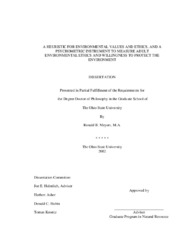| dc.description.abstract | The need for instruments to objectively and deeply measure public beliefs concerning environmental values and ethics, and relationship to environmental protection led to a project to integrate analytical techniques from ethics and educational psychology to identify beliefs in theories of value and obligation (direct and indirect), develop a 12-category system of environmental ethics, and a psychometric instrument with 5 scales and 7 subscales, including a self-assessment instrument for environmental ethics. The ethics were tested for ability to distinguish between beliefs in need to protect environment for human interests versus the interests or rights of animals and the environment. A heuristic for educators was developed for considering 9 dimensions of environmental and the ethics, and tested favorably. An exploratory survey (N = 74, 2001) of adult moral beliefs used 16 open-ended questions for moral considerability of, rights, treatment, and direct and indirect moral obligations to the environment. A 465 - item question bank was developed and administered (N = 191, 2002) to Ohio adults, and reduced to 73 items in 12 Likert-type scales (1-7, 1 strongly disagree) by analyzing internal consistency, response variability, interscale correlations, factorial, and ANOVA.
The results (beliefs concerning the general environment): Scale 1) Environmental Capacity (suffer mentally and physically) μ= 5.0, ą= 0.85; 1.1) Conativity, μ= 4.2, ą= 0.84; 1.2) Sentience, μ= 5.0, ą= 0.85; Scale 2) Value, μ= 5.0, ą= 0.92 ; 2.1) Intrinsic Value, μ= 3.4, ą= 0.84 ; 2.2) Animal and Environment‟s Rights, μ= 4.95, ą= 0.90; Scale 3) Moral Need to Protect, μ= 5.0, ą= 0.84; 3.1) Moral Acceptability of 4 Uses (medical research, zoo's, eating, killing to eat) μ= 4.8, ą= 0.89; 3.2) Usefulness, μ= 5.54, ą= 0.89; 4) Environmental Ethic ą = 0.73 (95% in ethics 7-12, the ecological ethics), highest population mean: "Ecological Phenomenalism", then "Ecological Ecocentrism"), modal category: "Ecological Ecocentrism" ; and Scale 5) Willingness to Protect Environment, Legally, μ=5.2, ą= 0.83. One factor per scale (2 factors for 2 dimensional environmental ethics scale). ANOVA: 4 scales independent, Scale 5 dependent: high predictive capacity -adjusted r2= 0.78. Scales demonstrated good reliability to measure complex moral beliefs. | en_US |

